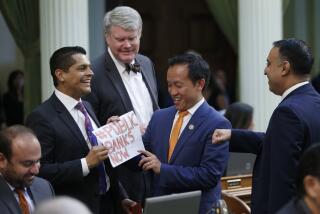Museum Cracks Open Vault of Old Bank Items : History: Officials give a preview of artifacts from the Bank of A. Levy. The collection is touted as a ‘Who’s Who’ of county pioneers.
- Share via
Hailing its rich historic value, officials of the Ventura County Museum of History and Art offered a sneak preview Friday of their new treasure trove from the Bank of A. Levy.
One by one, they explained the items: A teller’s pistol from the bank’s early days in Port Hueneme. An old cash box. Photographs. Deeds. A bag of sugar from the old Oxnard beet sugar factory.
And, somewhat incongruously for a collection of Ventura County historical items, a dramatic, wide-angle photograph of a 1913 game between the New York Giants and the Chicago White Sox. Museum officials figure that bank founder Achille Levy just liked baseball.
Ed Robings, the museum’s executive director, said the museum hopes to display a small sampling of the trove by the end of the month.
Librarian Charles Johnson said a couple of historians have already called the museum to inquire about what he called “a ‘Who’s Who’ of county pioneers.”
“Word is just starting to get out that we are the lucky recipient of this historical collection,” he said.
The museum requested the bank’s archives when it announced its sale to First Interstate Bank last fall. Robings said Bank of A. Levy President Marshall Milligan had once served on the museum’s board, and that Milligan’s father, Arthur Achille (Bud) Milligan, donated many historical items last summer.
Johnson said the bank, one of the earliest in California, was in the hands of a Levy descendant at the time of its sale. Marshall Milligan is the grandson of Julia Levy and John Milligan.
According to a 1975 article in Western States Jewish Historical Quarterly, bank founder Achille Levy came to San Francisco from Alsace, now part of France, in 1871.
He worked for a time at his uncle’s general merchandise store in Dixon, Calif., then settled in Hueneme, as it was then called, where he entered into a general merchandise business with Moise L. Wolff in 1874, the article said.
In the early 1880s, he set out on his own selling agricultural products and supplies, according to the article. The agricultural brokerage led him into banking and, by 1900, the launching of the first Bank of A. Levy. He died in February, 1922.
Robings said Levy was a banker with a heart of gold who assisted many local farmers. The Bank of A. Levy became known as “the bank that lima beans built,” but the visionary businessman also saw the potential of citrus.
Robings said Levy’s bank would often cement loan deals with just a handshake--no paperwork. To Levy, character outweighed collateral.
“And they had very few losses,” Robings said. “In those days, that sort of thing worked.
“The bank was more than just a cold business,” Robings said. “The family was involved in the community.”
The Bank of A. Levy informed museum officials a month ago that the historical collection was theirs as long as they came and picked it up.
Now the museum owns many financial documents, including 144 ledgers dating from 1895 to 1930. But it also has personal items that offer a glimpse into the lives of Achille Levy and his family.
For example, there is the hand-painted shaving mug Levy kept at the Oxnard barbershop he patronized daily. There is a book in Hebrew, printed in 1866, that Levy must have brought with him from Alsace. Charity mementos. An old family cookie recipe. A French primer signed in 1893 by Levy’s eldest child, Anna.
The display going up this month won’t be able to do the collection justice, Robings said. But he said the museum is seeking a federal grant to redesign its total collection with an eye to including a large part of the Levy trove.
More to Read
Sign up for Essential California
The most important California stories and recommendations in your inbox every morning.
You may occasionally receive promotional content from the Los Angeles Times.










